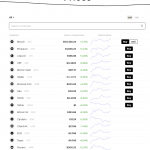In 1987 the U.S. military coined the term VUCA, referring to the increasing volatility, uncertainty, complexity and ambiguity of a multipolar world. It was used to describe one particular period of change. But it also perfectly describes the turmoil seen around the world over the last two years. COVID-19 and the reaction to it have thrown the world into chaos. Whole industries have been destroyed, while entirely new ways of working have become the norm. Meanwhile, vast government debt issuance and money printing to pay for the response will saddle the world with debt and inflation for years to come.
Beneath the COVID headlines, other changes are happening that will have similar long-lasting effects. The trade war between China and the U.S. and their ongoing decoupling are already having an enormous impact, with share price collapses, broken supply chains and mutual distrust. The rise of the crypto economy to a value of $1.6 trillion is shaking the global financial system. As we speak, policymakers around the world are grappling with new regulations to control crypto markets, while also working to set up their own crypto systems via central bank digital currencies (CBDC).
In normal times, such a wall of worry would result in a flight for safety, but even that is difficult in the new normal. With travel restrictions, gold is less portable than ever. Government bonds have flipped from offering a risk-free return to offering a return-free risk.
Put this all together and it’s likely we’re at a pivotal moment in financial history, where the current financial system and its attendant architecture have run their course, similar to the ending of the gold standard in 1971. As in 1971, when the financial system changes a whole new set of asset classes and sources of revenue will come into being.
NFTs by XWG
One asset class that is causing excitement is non-fungible tokens (NFT). These digital assets are immutable and exchangeable, offering a store of value and potentially a source of revenue. Creators around the world are flocking to platforms to stake their claims in this new ecosystem.
One such up-and-coming platform is X World Games (XWG), a decentralized gaming ecosystem built on the Binance Smart Chain and Ethereum. Players and creators can obtain X World Games (XWG) tokens through a variety of innovative games. The first game launched on the platform is Dream Card, which offers digital, collectible and customizable characters and NFTs that can be traded with XWG tokens.
It might seem a grandiose claim to link the fundamental rebuilding of the global financial system to the emergence of blockchain gaming assets. But the truth is decentralized finance (DeFi) systems – in which individuals can create, trade and monetize digital assets of their own making – is a radical departure from the analogue systems of wages, bank accounts, personal debt and credit scores. And while we are at the very early stages of this revolution, there are precedents that show how it could evolve.
The next article in this series will look at how the NFT craze has strong similarities to earlier alternative class assets such as financial derivatives. As in these asset classes, if you can fully understand the systems, the biases and incentives at work, there are ways to make strong cumulative trading gains from the NFT metaverse.
Most relevant is that by participating in an operational platform at the heart of the NFT metaverse, the risk of adverse price moves is reduced. It’s the equivalent of having your own stock market, asset platform or even selling picks and shovels to gold prospectors during a gold rush.
The novelty of these developments means there will be bumps along the way. But the opportunity is there now, as never before for individuals to join in the building of the new financial architecture – one that is strong enough to withstand the forces of VUCA.














